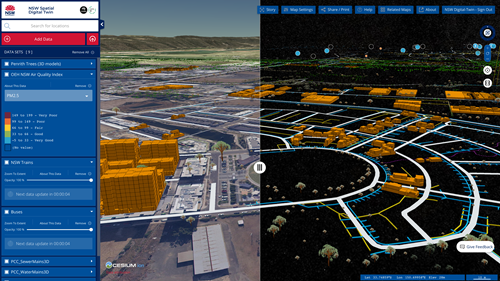
NSW Digital Twin © Copyright CSIRO Australia, 2022-02-24
A cutting edge 3D visualisation of Western Sydney was launched today in a demonstration of what is set to become a step change in urban planning.
The 'digital twin' technology was developed by CSIRO's Data61, the digital specialist arm of Australia's national science agency, and NSW Department of Customer Service's Spatial Services.
Launched today by Minister for Customer Service Victor Dominello, the NSW Spatial Digital Twin is a virtual 4D (3D + time) model of the Western Sydney area's built and natural environment.
Digital twin is an open platform that can visualise 3D and 4D data over time such as buildings, strata plans, terrain, property boundaries, utilities including power, water and sewer pipes.
Mats Henrikson, Geospatial Web Systems Group Leader at CSIRO's Data61, said the technology will allow planners, developers and policymakers to make more informed decisions, saving costs and creating efficiencies.
"The digital twin represents a step change in how we visualise environments and processes taking place in them. Till now decision makers have referred to property boundaries in 2D. Having them available in 3D together with how they have changed over time, and being able to easily share this with other related data makes it much easier to fully understand the context of the boundaries," Mr Henrikson said.
"Cities have never been so data rich as a result of connected sensors and many are growing vertically in addition to horizontally. This creates incredible opportunities to overlay 3D/4D data from satellite and drone technologies which is spatially accurate, to show the bigger picture of what's happening above and below the ground over time.
"An infrastructure developer can now use the digital twin to identify the location of underground utilities before building works commence, or see the potential impact of planned future infrastructure."
The digital twin also enables government to better communicate plans for infrastructure development to citizens.
The secure-by-design, federated platform incorporates Data61's open source catalogue technology MAGDA to bring together data from public agencies and the private sector.
It can be accessed by a web browser and while most of the data is available to the public, the built-in security features ensure only authorised individuals have access to certain types of data.
The NSW Spatial Digital Twin is built on Data61's TerriaJS platform which also powers National Map and the National Drought Map, an online tool that brings together information on Australian drought conditions and support measures.
This first phase of the NSW Spatial Digital Twin includes visualisations of the local government areas that comprise the Western Sydney City Deal and Greater Parramatta to the Olympic Peninsula.
Future phases of the digital twin in collaboration with NSW Spatial Services will include other areas of NSW.
Data-driven urban management is predicted to be a $5-10 billion export opportunity in the Asia-Pacific region by 2028.
Simon Barry, acting Director CSIRO's Data61, said the new visualisation brought together world-leading expertise in spatial visualisation, analytics and privacy preserving technologies from across the national science agency.
"By partnering with government and industry across the country, we can harness these technologies into federal collaboration platform enhancing Australia's smart cities and
delivering significant benefit to Australia's economy," Dr Barry said.
